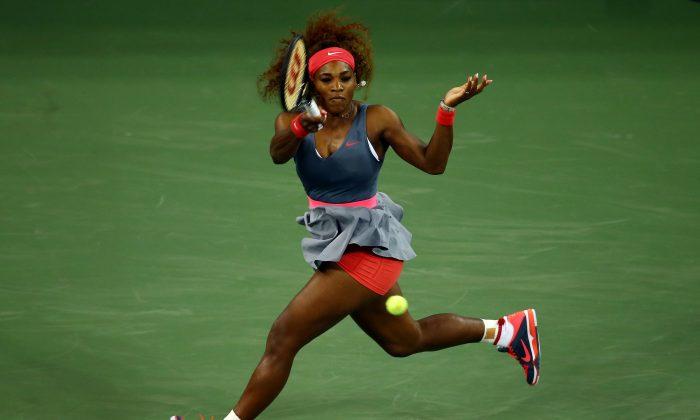NEW YORK—Tennis elbow affects as many as half of all tennis players at some point, according to WebMD. Based on these statistics, it’s easy to believe this common injury is an inevitable part of the game. But it’s not, according to Dr. Mark Kovacs, PhD, CTPS, executive director of the International Tennis Performance Association (ITPA).
Kovacs has worked with elite players for 12 years, teaching his clients proper stroke biomechanics and movement in order to improve performance and reduce injuries.
He said 99 percent of them don’t have tennis elbow.
Tennis elbow, formally defined as the inflammation of the tendon, makes fully extending the arm painful, and is a ubiquitous problem—not only for tennis players but for many people who overuse their arms performing a repetitive movement.
Instead of tennis elbow, Kovacs’ high-level players are more prone to have problems like shoulder strain, lower back pain, and ankle sprains. Theoretically, trained to move the correct way, a tennis player should not experience routine injuries like tennis elbow, even with high volume of play, said Kovacs.
Improper technique, inappropriate equipment for the person and level of play, and the failure to prepare the body for activity are all factors in the development of tennis elbow.
Training Tips
“Oftentimes, poor stroke mechanics and technique can be related to having insufficient hand, wrist, elbow, and shoulder muscle strength and endurance,” wrote Jim Zachazewski, clinical director and physical therapist at Massachusetts General Hospital.
“As muscles fatigue a player may compensate and use poor technique. This compensation may in turn lead to overuse and injury of the muscles, tendons and other structures that surround the elbow and shoulder.”
To prevent arm injuries, stop and rest before reaching the point of fatigue so you are not tempted to soldier on.
If you are new to the sport, ramp up gradually.
Dr. Joshua Dines, an orthopedic surgeon at the Hospital for Special Surgery, has seen his share of recreational tennis players who have tried to do too much too soon.
He suggests new players hit balls for 15 minutes at a time with a rest in between. Then, slowly increase practice time as strength and endurance build up.
Remember to do light stretches during warm-ups and cool-downs.
Consciously work on strength and endurance, too. Zachazewski’s program at Massachusetts General Hospital uses light weights to strengthen key muscles: rotator cuff muscles, muscles that control the position of your scapula, and your wrist extensor and flexor muscles. Having strong shoulder and wrist muscles reduce the chances of elbow injuries, according to Zachazewski.
If you intend to improve your skills over the long term, get coached on how to play efficiently and safely. Make sure to choose a coach with credentials from the United States Tennis Association, United States Professional Tennis Association, or the International Tennis Performance Association.
Racket Selection Guidelines
While the industry doesn’t have all the answers yet about how rackets impact our bodies, here is a summary of present guidelines when choosing a tennis racket, summarized from HumanKinetics.com and TennisExpress.com
Grip Size
A grip that is too large or too small for your hand will strain the muscles in the hand and arm.
Hold the racket with your dominant hand and slide the index finger of the other hand between the tips of your fingers and the base of your palm. The optimal size grip will allow the width of one index finger in this area. Most men have a grip size between 4 1/2 and 4 3/4 inches and most women 4 1/8 to 4 ½ inches.
Head Size
Oversized and mid-sized heads are good for beginners and the elderly as they generate more power and make it easier to hit the ball. Traditional sizes (under 105 square inches) are generally used by accomplished players.
Length
Most rackets are 27 to 28 inches long. Longer rackets offer more power but are less maneuverable.
Weight
Generally, heavier rackets produce more power, less torque, and offer better control. They require more strength to manipulate and make the player tire easily. Lighter rackets are more suitable for doubles players because they make serves, returns, volleys, and overheads easier.
Super Light—8.9 ounces or less (Unstrung)
Light—9 to 9.5 ounces (Unstrung)
Medium—9.6 to 10.4 ounces (Unstrung)
Heavy—10.5 to 10.9 ounces (Unstrung)
Very Heavy—11 ounces and above (Unstrung)
Balance
Balance refers to whether the head or grip is heavier. Heavier heads offer more stability, power, and spin while sacrificing mobility. Lighter heads are more mobile but require more work from the player.
Strings
Tighter strings offer more control and accuracy. Looser strings give more bounce but offer less control. Strings are manufactured in natural and synthetic gut, and polyester. These materials have different properties that affect the function of a racket.
Sources: Tennis Express, Human Kinetics.







Friends Read Free